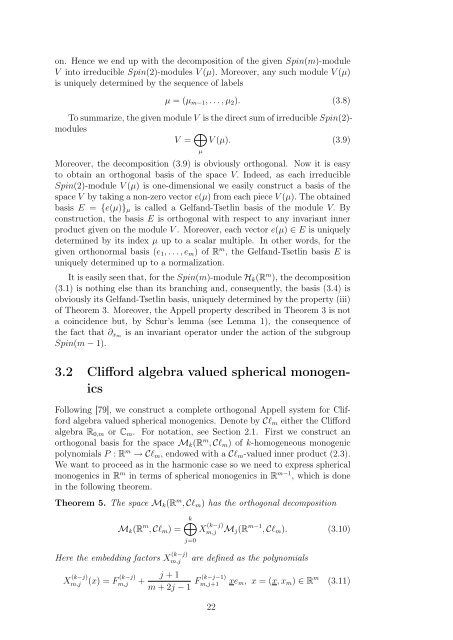Hypercomplex Analysis Selected Topics
Hypercomplex Analysis Selected Topics
Hypercomplex Analysis Selected Topics
You also want an ePaper? Increase the reach of your titles
YUMPU automatically turns print PDFs into web optimized ePapers that Google loves.
on. Hence we end up with the decomposition of the given Spin(m)-module<br />
V into irreducible Spin(2)-modules V (µ). Moreover, any such module V (µ)<br />
is uniquely determined by the sequence of labels<br />
µ = (µm−1, . . . , µ2). (3.8)<br />
To summarize, the given module V is the direct sum of irreducible Spin(2)modules<br />
V = <br />
V (µ). (3.9)<br />
µ<br />
Moreover, the decomposition (3.9) is obviously orthogonal. Now it is easy<br />
to obtain an orthogonal basis of the space V. Indeed, as each irreducible<br />
Spin(2)-module V (µ) is one-dimensional we easily construct a basis of the<br />
space V by taking a non-zero vector e(µ) from each piece V (µ). The obtained<br />
basis E = {e(µ)}µ is called a Gelfand-Tsetlin basis of the module V. By<br />
construction, the basis E is orthogonal with respect to any invariant inner<br />
product given on the module V . Moreover, each vector e(µ) ∈ E is uniquely<br />
determined by its index µ up to a scalar multiple. In other words, for the<br />
given orthonormal basis (e1, . . . , em) of R m , the Gelfand-Tsetlin basis E is<br />
uniquely determined up to a normalization.<br />
It is easily seen that, for the Spin(m)-module Hk(R m ), the decomposition<br />
(3.1) is nothing else than its branching and, consequently, the basis (3.4) is<br />
obviously its Gelfand-Tsetlin basis, uniquely determined by the property (iii)<br />
of Theorem 3. Moreover, the Appell property described in Theorem 3 is not<br />
a coincidence but, by Schur’s lemma (see Lemma 1), the consequence of<br />
the fact that ∂xm is an invariant operator under the action of the subgroup<br />
Spin(m − 1).<br />
3.2 Clifford algebra valued spherical monogenics<br />
Following [79], we construct a complete orthogonal Appell system for Clifford<br />
algebra valued spherical monogenics. Denote by Cℓm either the Clifford<br />
algebra R0,m or Cm. For notation, see Section 2.1. First we construct an<br />
orthogonal basis for the space Mk(R m , Cℓm) of k-homogeneous monogenic<br />
polynomials P : R m → Cℓm, endowed with a Cℓm-valued inner product (2.3).<br />
We want to proceed as in the harmonic case so we need to express spherical<br />
monogenics in R m in terms of spherical monogenics in R m−1 , which is done<br />
in the following theorem.<br />
Theorem 5. The space Mk(R m , Cℓm) has the orthogonal decomposition<br />
Mk(R m , Cℓm) =<br />
Here the embedding factors X (k−j)<br />
m,j<br />
X (k−j)<br />
m,j (x) = F (k−j)<br />
m,j +<br />
k<br />
j=0<br />
j + 1<br />
m + 2j − 1<br />
X (k−j)<br />
m,j Mj(R m−1 , Cℓm). (3.10)<br />
are defined as the polynomials<br />
F (k−j−1)<br />
m,j+1 xem, x = (x, xm) ∈ R m (3.11)<br />
22

















